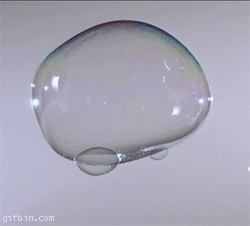I am a bit puzzled because I can see two possible reasons, first one is more common and the other one makes sense too, so here they go:
1) balloon pops because of the fact that after pressure is applied over small area (tip of the needle for example) hole is created
2) balloon pops because after pressure is applied over small area pressure inside balloon rises which causes balloon to pop
Which one is it??? Thanks a million!
Answer
How about neither of them? The balloon pops because of surface tension of the balloon!
Surface tension is what keeps the balloon in shape. Now when you puncture the balloon with a needle, the force along the edge will be imbalanced and the tension will pull the surface without anything cancelling it. Because of the rubbery nature of the latex, it will shrink and collapse in few milliseconds.
Also, if you're asking about the pop sound, there are two effects involved:
- The air inside the balloon has higher pressure than the atmosphere, so when the balloon is suddenly removed, the pressure gradient(sound wave) will propagate.
- At the end of balloon burst, it will zap on itself which will produce a noise as well.
Googling some slow motion images of balloon or bubble bursting might help with the visualizations.

No comments:
Post a Comment